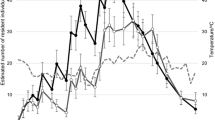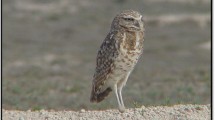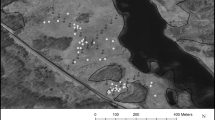Abstract
Little is known of the ecology and population dynamics of the world’s largest avian frugivore. This study investigated the population of endangered southern cassowary at Mission Beach, northeast Australia, and examined the problems associated with determining population size and density of this keystone species. Using the results of an intensive field survey aimed at estimating absolute numbers of individual cassowaries, the appropriate sampling methodology for rare and elusive species was explored. Approximately 102 km2 of rainforest was surveyed using 346 km of search transects. Of a total of 110 cassowaries, there were 49 adults (28 male, 19 female, 2 unknown), 28 subadults, 31 chicks, and 2 independent birds of unknown status. This is approximately 35% of the adult population previously estimated for the Mission Beach area. Overall adult cassowary density was 0.48 adults/km2; the density of independent birds, i.e. adults and subadults, was 0.78 birds/km2. Mean indicative home range (IHR) for adult females and males was 2.13 and 2.06 km2, respectively. Mean IHR of subadults was smaller at 0.95 km2. It was concluded that the previous practice of surveying small areas at Mission Beach (<4 km2) has led to consistent overestimation of cassowary population density, up to six times its real number. It is shown that a sample plot between 5 and 15 km2 is necessary to approximate true cassowary density. These findings have significant application to the conservation of cassowaries in New Guinea and in the Wet Tropics World Heritage Area of Australia.





Similar content being viewed by others
References
Bentrupperbäumer J (1998) Reciprocal ecosystem impact and behavioural interactions between cassowaries, Casuarius casuarius and humans, Homo sapiens. Ph.D. Thesis, James Cook University, Townsville
Coddington C, Cockburn A (1995) The mating system of free-living emus. Aust J Zool 43:365–372
Crome F (1976) Some observations on the biology of the cassowary in northern Queensland. Emu 76:8–14
Crome F, Bentrupperbäumer J (1991) Management of cassowaries in the fragmented rainforests of north Queensland (Phase 1). A consultancy report to The Endangered Species Program of the Australian National Parks and Wildlife Service
Crome F, Bentrupperbaumer J (1992) Cassowaries in north Queensland II: Fieldwork in 1992. A consultancy report to The Endangered Species Program of the Australian National Parks and Wildlife Service
Crome F, Moore L (1990) Cassowaries in northeast Queensland: a report of a survey and a review and assessment of their status and conservation and management needs. Aust Wildl Res 17:369–385
Crome F, Moore L (1993) Cassowary populations and their conservation between the Daintree River and Cape Tribulation. Vol. 2 Background, survey results and analysis. A CSIRO report to the Douglas Shire Council
Environment Protection and Biodiversity Conservation Act 1999. Commonwealth Government Printer, Australia
Goosem S (1992) Draft Management Plan Mission Beach Area, North Queensland. Queensland Department of Environment and Heritage Report, Far Northern Region, Cairns
Goosem S (2000) Renomination of the cassowary on the Commonwealth Endangered Species Schedule. Queensland Government Printer, Brisbane
Johnson A, Bino R, Igag P (2004) A preliminary evaluation of the sustainability of cassowary (Aves: Casuariidae) capture and trade in Papua New Guinea. Anim Cons 7:129–137
Landsborough-Thompson A (1964) A new dictionary of birds. Thomas Nelson and Sons Ltd., London and Edinburgh
Mack A (1995) Distance and non-randomness of seed dispersal by the dwarf cassowary Casuarius bennetti. Ecography 18(3):286–295
Mack A, Wright D (2005) The frugivore community and the fruiting plant flora in a New Guinea rainforest: identifying keystone frugivores. In: Lawrence Dew J, Jean Philippe Boubli (eds) Tropical fruits and frugivores: the search for strong interactors. Springer, The Netherlands, pp 184–203
Mack A, Wright D (1996) Notes on occurrence and feeding of birds at the Crater Mountain Biological Research Station, Papua New Guinea. Emu 96:89–101
Miller P, Lacy R (1999) VORTEX: A stochastic simulation of the extinction process. Version 8 users manual. Conservation Breeding Specialist Group
Moore L, Crome F (1992) Report on a survey of cassowary populations in the Whitfield Range, north Queensland. Internal Research Report, CSIRO
Moore L (1996a) Part 1: cassowary monitoring program, Daintree lowlands: report for the Wet Tropics Management Authority
Moore L (1996b) Part 2: cassowary monitoring program, Daintree lowlands: report for Wet Tropics Management Authority
Moore L (1998) Cassowary conservation roads: a management strategy and road upgrade assessment for El Arish and Tully-Mission Beach roads, Mission Beach. Report for Queensland Department of Main Roads
Moore L (1999) Cassowary management plan I. Daintree. Report for the Wet Tropics Management Authority, Cairns, Queensland
Moore L (2003) Ecology and population viability analysis of the southern cassowary (Casuarius casuarius johnsonii): Mission Beach, North Queensland. MSc thesis, James Cook University, Queensland
Nature Conservation Act 1992. Queensland Department of Environment and Heritage. Brisbane, Australia
Small A (1998) Vegetation of the Maria Creek to Hull River Coastal Area. In: Far North Queensland 2010 Regional Environment Strategy. Queensland Government Printer
Stocker G, Irvine A (1983) Seed dispersal by cassowaries (Casuarius casuarius) in north Queensland’s rainforest. Biotropica 15:170–176
Tracey J, Webb L (1975) Vegetation of the humid tropical region of North Queensland. CSIRO Division of Plant Industry, Indooroopilly
Westcott D (1999) Counting cassowaries: what does cassowary sign reveal about their abundance? Aust Wildl Res 26:61–67
Acknowledgments
I am grateful to Professor Chris Johnson for supervising the original M.Sc. project and providing constructive comments on this manuscript. My wife Dr. Nicole Moore also contributed significantly, both with her editing and insightful observations. I would also thank Dr. Andrew Mack, Prof. Dr. Peter H. Becker, and an anonymous reviewer for helpful and constructive comments. My greatest thanks, however, go to the people of Mission Beach and in particular those individuals who make up the Community for Coastal and Cassowary Conservation (C4). Their knowledge of the local cassowary population and their untiring efforts to conserve the species at Mission Beach are legendary. This study was conducted within the guidelines imposed by an Ethics Approval granted by James Cook University, Townsville, Australia.
Author information
Authors and Affiliations
Corresponding author
Additional information
Communicated by P.H. Becker.
Rights and permissions
About this article
Cite this article
Moore, L.A. Population ecology of the southern cassowary Casuarius casuarius johnsonii, Mission Beach north Queensland. J Ornithol 148, 357–366 (2007). https://doi.org/10.1007/s10336-007-0137-1
Received:
Revised:
Accepted:
Published:
Issue Date:
DOI: https://doi.org/10.1007/s10336-007-0137-1




